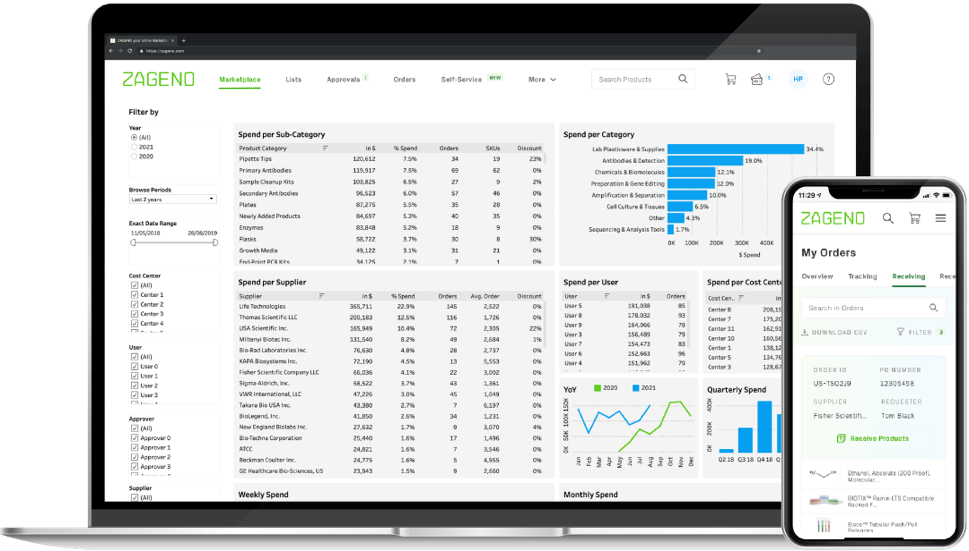So, you've raised startup funding for your biotech or R&D lab. What’s next? When planning out initial lab setup and ongoing lab budget needs, conscious spending and thoughtful planning help ensure that the lab is maximizing each precious dollar.
Growing a biotech is challenging and exciting, and going from incubator to an independent lab requires a combination of passion for the research and financial know-how. Biotechs are businesses as much as they are laboratory environments and the biotech startups who grow the fastest use lean business processes to achieve their goals.
How to Develop an R&D Lab Budget
1. Lab Space
Lab space is hard to come by, expensive to set up, and critical to growing R&D operations. Being prepared with all of the utility needs for your research, having enough space for expansion if that time comes, and ensuring it all fits within your price range are key initial considerations.
Don’t forget to consider your lab employees’ commutes to keep their stress low, and even being in an area with convenient amenities nearby can help with lab morale.
When moving into a new lab space, think about safety needs, service supplier access, and how to safely move if you’re relocating from an incubator or shared lab space. New lab setup services provide expert handling and planning and help to avoid higher costs and delays.
2. Lab supplies and equipment
Most lab spaces will not have much of the specific equipment necessary for each unique lab, so explore options for shared equipment use or plan to order equipment ahead of time in the case of backordered machines.
Be careful not to sacrifice quality over price. It may seem like the cheapest option to buy older equipment, but operating costs can actually come down if there is a more time or energy efficient option on the market. Take advantage of the newest technology where possible.
For lab supply purchasing, utilize the latest tech like lab supply marketplaces, which offer multiple suppliers and add new suppliers regularly, but serve as a singular vendor of record. Top biotech lab managers cite their biggest frustrations around managing research as searching for specific supplies, the lab supply ordering process itself, and checking with vendors on lab supply orders. With a lab supply marketplace, researchers can access detailed reporting and easier search and compare functions for products, and save serious budget and time.
3. Ongoing maintenance
Allocate budget for the unexpected. In this line of work, surprises happen frequently. Employees will leave, equipment will break down, and inevitably, things like this will cost money.
4. Vendors and services
This is another area where old ways can be costly. It is easy in this field to just use vendors that have always been used, but this is rarely the most cost effective way to operate. Most likely, your lab will be taking a slightly different approach than your past projects, so reevaluate vendors with the setup of a new lab.
Using lab supply marketplaces saves growing biotechs around 20% of their lab supply budget — three quarters of that savings comes from the cost comparison feature alone.
5. Lab software
Lab software to invest in using biotech startup funding can include:
- Lab inventory management software
- Lab supply marketplaces
- LIMS
- Experiment tracking and project management tools
- Video conferencing or other team collaboration tools
6. Lab staff
Hiring and sourcing researchers, lab technicians, lab managers, and other lab staff is a major expense for new biotechs. Hiring fees for pharmaceutical and biotech companies can range between 22-24% of an employee’s first year salary.
Use a scientific or biotech-specific career website to post available job listings. Biotech recruiters can help to source specialized roles and speed up time to hire, despite requiring an up-front payment.
7. Lab training and education
Budget for initial and ongoing lab training and education.
Effective safety training and ongoing educational opportunities help with two things: reducing the risk for injuries or damaged research experiments, and retaining lab staff and providing opportunities for advancement in the organization, which saves on hiring and turnover costs.
8. Innovative lab technology and hardware
While the current technology being used may be crucial to the initial setup of the lab, keeping your eye on the development market can be a great way to stretch your dollars in the starting phase of growth. Partner with lab technology startups or experiment with new tools available to see how they can improve overall lab efficiency.
Using Business Strategy to Manage Biotech Lab Spend
Biotech startups are goaled on business milestones as much as research milestones. Always consider general optimization practices to run lean labs.
1. Set up efficient lab workflows.
What’s easiest or most convenient or comfortable might not be the most efficient.Evaluate if everything is in the best place and has an organizational system, if tasks are being done in the right order, or if the right people are doing the tasks they should be. Simple switches can save hours, which can add up.
2. Work with lab managers and researchers to identify areas for automation and integrated lab software.
On fast-paced technology and business teams, operations managers are constantly looking for opportunities to make processes more efficient using integrations, automation, and software. A common saying in the tech world is to look for all processes currently using spreadsheets and replace them with software.
Survey scientists and work with lab managers to catalog how lab staff is spending their time, then look for processes that could be automated or sped up by lab software, like a LIMS. Additionally, with many labs incorporating remote and hybrid work models, software can give researchers better options to conduct some of their work from home.
3. Create reporting and analytics dashboards to monitor ongoing lab spend.
Pulling custom reports month over month from several different locations, or gathering receipts on a semi-regular basis can quickly be deprioritized or skipped when the lab gets busy. Set up a dashboard to keep an eye on lab spend or use a lab supply purchasing or budgeting software that includes pre-built dashboards pulling in purchasing information.

ZAGENO's spend analytics dashboard
4. Regularly audit lab budget and track lab spend.
The final step once you have urged lab staff to keep careful track of their ordering and inventory, is to double check on a regular schedule that everything is being properly documented.
Make sure that the financial statements are lining up with the invoices of your vendors and that the payroll is matching up with each employee's payment situation. Simple checks like these can often expose glaring oversight, like constantly ordering a supply that never gets used.
Looking for ways to streamline lab ordering and set your growing biotech up for continued success? Explore ZAGENO’s life science, biotech, and pharma lab management solutions.




